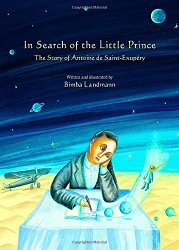
The Story of Antoine de Saint-Exupéry
Review posted August 19, 2015.
Eerdmans Books for Young Readers, Grand Rapids, Michigan, 2014. First published in Italy in 2013. 36 pages.
Here’s the life story of the author of The Little Prince in oversize picture book form. The pictures tend to be fanciful – showing Tonio’s boyhood dreams – but I like that the narrative is straightforward and easy to follow.
The book tells about how early Antoine became interested in flying, and how he eventually was able to fulfill that dream. It also gives us a poem he wrote at 12 years old about his first flight in an airplane – showing us that his love of writing began early, too.
This book doesn’t have notes at the back. Words are put into the mouths of family members and we’re told about Antoine’s dreams. Many quotations come from letters, but we’re not explicitly told where something like this comes from:
Only writing gave him comfort.
Short stories. Stories to calm his desire to flee.
And to try and get his soul, heavier and heavier by the day, to fly.
“What’s wrong with you?” his friends asked him. “You’ve got a good job; you earn plenty. What more do you want?”
Tonio’s coworkers only ever talked about money, houses, golf, and cars.
They did not feel, as he did, that they were the inhabitants of a wandering planet suspended in the Milky Way.
“I’m bored,” he sighed.
He needed to be in touch with the wind, with the stars.
He had to start flying again.
So this might bother sticklers. I have to admit – it didn’t bother me.
We also see how he developed the themes that eventually made their way into The Little Prince.
The more Antoine drew, the more the boy resembled him.
Like him, the boy didn’t understand people who want to be rich.
He too was sad at seeing his planet smothered by baobabs,
The way the earth was smothered by war.
He too had tamed a fox.
He too loved a rose . . .
Antoine wrote a fairy tale like the ones he used to listen to as a child:
it was a fairy tale about a little prince who came from far away,
and it helped him find the innocence of his childhood once more,
when he was simply Tonio.
This book will make readers – children or adults – want to pick up The Little Prince again. And perhaps think a little more deeply about the ideas behind it.
